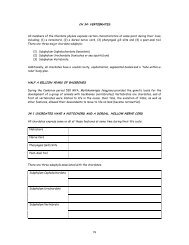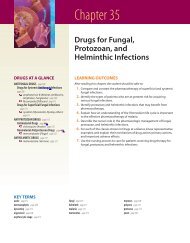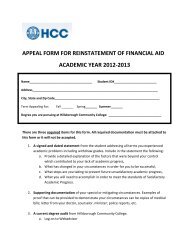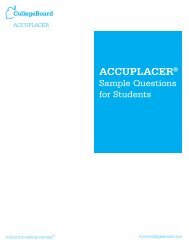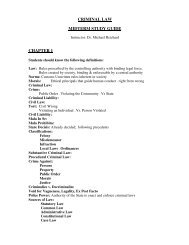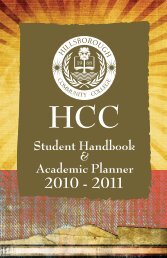Antimicrobial Drugs
Antimicrobial Drugs
Antimicrobial Drugs
Create successful ePaper yourself
Turn your PDF publications into a flip-book with our unique Google optimized e-Paper software.
M34_ADAM9811_03_SE_CH34.QXD 12/30/09 1:16 PM Page 484<br />
484 Unit 5 The Immune System<br />
apply to all antibiotic therapies; however, the nurse should<br />
individualize the plan of care based on the patient’s condition,<br />
the infection, and the antibacterial agent prescribed.<br />
Penicillins<br />
Although not the first anti-infective discovered, penicillin<br />
was the first mass-produced antibiotic. Isolated from the<br />
fungus Penicillium in 1941, the drug quickly became a miracle<br />
product by preventing thousands of deaths from infections.<br />
The penicillins are listed in Table 34.2.<br />
34.8 Pharmacotherapy<br />
with Penicillins<br />
Penicillins kill bacteria by disrupting their cell walls. Many<br />
bacterial cell walls contain a substance called penicillin-binding<br />
protein that serves as a receptor for penicillin. Upon binding,<br />
penicillin weakens the cell wall and allows water to enter,<br />
thus killing the organism. Human cells do not contain cell<br />
walls; therefore, the actions of the penicillins are specific to<br />
bacterial cells. Gram-positive bacteria are the most commonly<br />
affected by the penicillins, including streptococci and<br />
staphylococci. Penicillins are indicated for the treatment of<br />
pneumonia; meningitis; skin, bone, and joint infections;<br />
stomach infections; blood and valve infections; gas gangrene;<br />
tetanus; anthrax; and sickle-cell anemia in infants.<br />
The portion of the chemical structure of penicillin that<br />
is responsible for its antibacterial activity is called the betalactam<br />
ring. Some bacteria secrete an enzyme, called beta-lactamase<br />
or penicillinase, which splits the beta-lactam ring. This structural<br />
change allows these bacteria to become resistant to the effects<br />
of most penicillins. Since their discovery, large numbers of resistant<br />
bacterial strains have emerged that limit the therapeutic<br />
usefulness of the penicillins. The action of penicillinase is<br />
illustrated in ➤ Figure 34.3. Other classes of antibiotics also<br />
contain the beta-lactam ring, including the cephalosporins,<br />
carbapenems, and monobactams.<br />
Chemical modifications to the natural penicillin molecule<br />
produced drugs offering several advantages. They include<br />
the following:<br />
● Penicillinase-resistant penicillins: Oxacillin and<br />
cloxacillin (Cloxapen) are examples of drugs that are<br />
effective against penicillinase-producing bacteria. These<br />
are sometimes called antistaphylococcal penicillins.<br />
● Broad-spectrum penicillins: Ampicillin (Principen) and<br />
amoxicillin (Amoxil, Trimox) are effective against a wide<br />
range of microorganisms and are called broad-spectrum<br />
TABLE 34. 2 Penicillins<br />
Drug Route and Adult Dose (max dose where indicated) Adverse Effects<br />
NATURAL PENICILLINS<br />
penicillin G benzathine (Bicillin) IM; 1.2 million units as a single dose (max: 2.4 million units/day) Rash, pruritus, diarrhea, nausea, fever,<br />
penicillin G procaine (Wycillin)<br />
IM; 600,000–1.2 million units/day (max: 4.8 million units/day)<br />
drowsiness<br />
penicillin G sodium/potassium<br />
IM/IV; 2–24 million units divided every 4–6 h (max: 80 million units/day)<br />
Anaphylaxis symptoms, including<br />
angioedema, circulatory collapse and<br />
penicillin V (Pen-Vee K,Veetids,Vee-Cillin-K) PO; 125–250 mg qid (max: 7.2 g/day)<br />
cardiac arrest; nephrotoxicity<br />
PENICILLINASE-RESISTANT<br />
cloxacillin (Cloxapen)<br />
dicloxacillin<br />
nafcillin<br />
oxacillin<br />
BROAD-SPECTRUM (AMINOPENICILLINS)<br />
amoxicillin (Amoxil,Trimox)<br />
amoxicillin–clavulanate (Augmentin)<br />
ampicillin (Principen)<br />
bacampicillin (Spectrobid)<br />
EXTENDED-SPECTRUM (ANTIPSEUDOMONAL)<br />
carbenicillin (Geocillin)<br />
piperacillin sodium<br />
piperacillin tazobactam (Zosyn)<br />
ticarcillin (Ticar)<br />
PO; 250–500 mg bid<br />
PO; 125–500 mg qid (max: 4 g/day)<br />
PO; 250 mg–1 g qid (max: 12 g/day)<br />
PO; 250 mg–1 g qid (max: 12 g/day)<br />
PO; 250–500 mg every 6 h (max: 1,750 mg/day)<br />
PO; 250 or 500 mg tablet (each with 125 mg clavulanic acid) every 8–12 h<br />
PO/IV/IM; 250–500 mg every 6 h (max: 4 g/day PO or 14 g/day IV/IM)<br />
PO; 400–800 mg bid<br />
PO; 382–764 mg qid<br />
IM; 2–4 g tid–qid (max: 24 g/day)<br />
IV; 3.375 g qid over 30 min<br />
IM; 1–2 g qid (max: 24 g/day)<br />
Italics indicate common adverse effects; underlining indicates serious adverse effects.<br />
# 102887 Cust: PE/NJ/CHET Au: ADAMS Pg. No. 484<br />
Title: Pharmacology for Nurses Server: Jobs2<br />
C/M/Y/K<br />
Short / Normal<br />
DESIGN SERVICES OF<br />
S4CARLISLE<br />
Publishing Services



